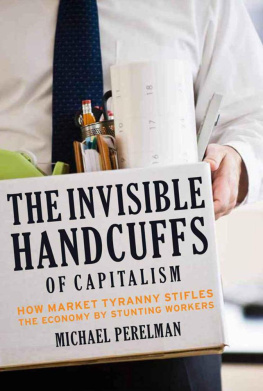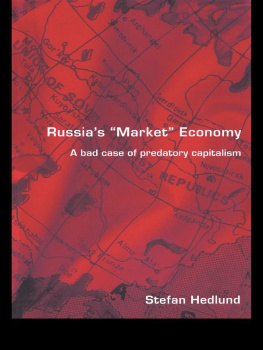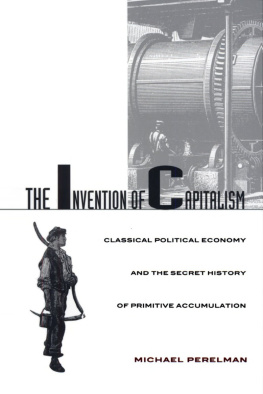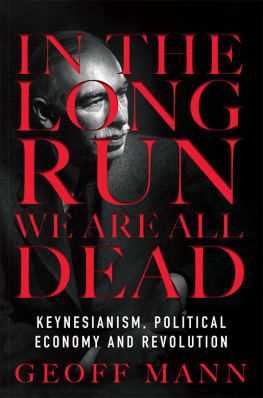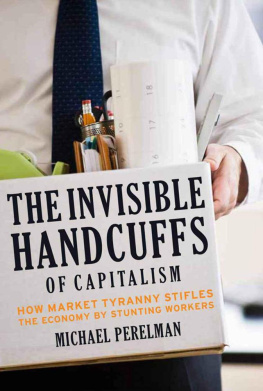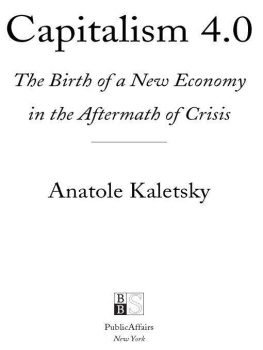Perelman - The Invisible Handcuffs of Capitalism: How Market Tyranny Stifles the Economy by Stunting Workers
Here you can read online Perelman - The Invisible Handcuffs of Capitalism: How Market Tyranny Stifles the Economy by Stunting Workers full text of the book (entire story) in english for free. Download pdf and epub, get meaning, cover and reviews about this ebook. City: New York, year: 2011, publisher: Monthly Review Press;NYU Press academic, genre: Politics. Description of the work, (preface) as well as reviews are available. Best literature library LitArk.com created for fans of good reading and offers a wide selection of genres:
Romance novel
Science fiction
Adventure
Detective
Science
History
Home and family
Prose
Art
Politics
Computer
Non-fiction
Religion
Business
Children
Humor
Choose a favorite category and find really read worthwhile books. Enjoy immersion in the world of imagination, feel the emotions of the characters or learn something new for yourself, make an fascinating discovery.
The Invisible Handcuffs of Capitalism: How Market Tyranny Stifles the Economy by Stunting Workers: summary, description and annotation
We offer to read an annotation, description, summary or preface (depends on what the author of the book "The Invisible Handcuffs of Capitalism: How Market Tyranny Stifles the Economy by Stunting Workers" wrote himself). If you haven't found the necessary information about the book — write in the comments, we will try to find it.
The Invisible Handcuffs of Capitalism: How Market Tyranny Stifles the Economy by Stunting Workers — read online for free the complete book (whole text) full work
Below is the text of the book, divided by pages. System saving the place of the last page read, allows you to conveniently read the book "The Invisible Handcuffs of Capitalism: How Market Tyranny Stifles the Economy by Stunting Workers" online for free, without having to search again every time where you left off. Put a bookmark, and you can go to the page where you finished reading at any time.
Font size:
Interval:
Bookmark:
The Invisible Handcuffs of Capitalism
How Market Tyranny Stifles the Economy by Stunting Workers
by Michael Perelman

Copyright 2011 by Monthly Review Press
All rights reserved
Library of Congress Cataloging-in-Publication Data
Perelman, Michael.
The invisible handcuffs : how market tyranny stifles the economy by stunting workers / by Michael Perelman.
p. cm.
Includes bibliographical references and index.
ISBN 978-1-58367-229-7 (pbk. : alk. paper) ISBN 978-1-58367-230-3 (cloth : alk. paper) 1. Labor. 2. Work. 3. Capitalism. I. Title.
HD4904.P386 2010
331.13dc22
2010050845
Monthly Review Press
146 West 29th Street, Suite 6W
New York, New York 10001
www.monthlyreview.org
www.MRzine.org
5 4 3 2 1
All books are collective, but I am fortunate in working with a wonderful collective, beginning with Blanche Perelman, whose tolerance and support has let me obsess about the causes and consequences of economics neglect of work, workers, and working conditions. Next comes Michael Yates, who was far more than an editor, relentlessly prodding me to think harder and more clearly. He deserves a fair share of any credit due to this book. Edward Roualdes gave up a vacation in Hawaii to work with me on the manuscript, catching me when I was insufficiently clear. David Ward also gave detailed editorial suggestions, as did my colleagues Richard Ponarul and Samir Nissan offered valuable suggestions. My first editor, Margo Crouppen, helped me during the early stages.
Setting the Stage
The Invisible Handcuffs tells a unique story about the damage that capitalism inflicts on society. Many authors have addressed the cultural, social, ecological, or ethical shortcomings of markets, such as the unequal distribution of income. Others have stressed the inherent instability of capitalism, which leads to recurrent economic crises.
This book does something different. It takes aim at capitalism in terms of its own basic rationalethe creation of an efficient method of organizing production. In particular, The Invisible Handcuffs concentrates on a largely ignored dimension of market inefficiency: how the failure by economists and employers alike to adequately take work, workers, and working conditions into account has led to actions that have stifled the economy.
The inattention of mainstream economists to work, workers, and working conditions has not been accidental. It has been a key part of a centuries-long effort, beginning at least as far back as Adam Smith, to construct an ideology that would shield markets from criticism.
Some mainstream economists have dared to look in this direction, but they have been treated harshly. So most economists have practiced self-censorship and shied away from examining work, workers, and working conditions. There have been sharp disagreements about minor points, but these have only helped to obscure the virtual unanimity about larger issues.
There have been times, especially during economic crises, when the usually closed ranks of economists have opened a bit. During the recent Great Recession for example, many people saw or at least suspected that the fanciful economic theories had helped to bring about the economic crisis. However, we shall see how similar awakenings have accompanied past crises, but once these passed, the old ideology, again masquerading as science and as always buttressed by imposing mathematical models, reasserted itself. Ironically, this return to orthodoxy made the economy even more vulnerable to crisis.
The approach of this book is historical, because this is especially useful in understanding the continuing hold of mainstream economic theory. As William Faulkner wrote in Requiem for a Nun, The past is never dead. Its not even past.
An Ideological Fairy Tale
Almost 250 years ago, Adam Smith, often described as the father of modern economics, introduced the idea of the invisible hand, which has since become a popular metaphor for expressing unbounded faith in capitalism. He proposed that the market coordinated peoples activities in such a beneficent way that one might well imagine that an invisible hand was at work creating an economy that was both fair and efficient.
Smith maintained that within the rules of the market, people were free to do as they pleased. He recognized that the market did impose discipline, but he insisted that it did so fairly, in the sense that the market did not favor any persons or groups.
Smiths argument has a certain power and persuasiveness, and, because he was skilled in rhetoric, a subject he taught at his university, he was able to convincingly present the economy as a voluntary system, carefully excluding dramatic economic changes that were already under way, literally in his own neighborhood. But as we will see, Smiths idea of an invisible hand guiding the economy toward a desirable social outcome took hold because it fit the needs of those powerful persons who owned the land, raw materials, and capital upon which everyone else depends.
Building upon Smith, later economists created a more sophisticated theory, while still maintaining the basic ingredients of Smithian economics, especially his emphasis on individual commercial transactions (buying and selling) as the central feature of capitalist economies. Production itself, which is always a social and not an individual process, was excluded.
The dogmatic insistence on framing the economy this way obscures any consideration of fundamental questions about work, workers, and working conditions. For example, economists may look at workers in terms of the level of wages or the extent of unemployment (the absence of a buyer-seller transaction in the job market), but the actual content of peoples existence as workers on the job passes unnoticed. Even where economists take note of workers skills, they reduce it to the level of a commodityidentifying skill as human capital, to be sold to a willing buyer.
Within this narrow market perspective, social relations become invisible. Workers are not just creatures that inhabit the workplace. They live within families, a class, and a society. If these relationships are ignored, the potential for substantial progress in grasping the economy is virtually nil.
An Ideology Comes Unglued
Although the ideological victory of mainstream economics has been effective in staving off critiques, it has been a mixed blessing for employers and their allies in government. While economics has helped shield them from criticism as well, it also has mesmerized them into believing things that are not true. They, too, have neglected work, workers, and working conditions, and this has made for bad management and bad policy. People in power became lulled into ignoring the importance of the productive activities that form the foundation of a strong economy.
The subject of conflicts between ideological and productive needs runs through this book. The ideology of economics intersected with the personal needs of the people who run the economy. These captains of industry enjoyed believing that their authority was the result of their own talents and hard work. Measures that could make workers more productive might threaten to undermine either the rationale for or the authority of the capitalists. So when they had to choose between justifying their position and improving workers productive potential, they opted for the former.
Next pageFont size:
Interval:
Bookmark:
Similar books «The Invisible Handcuffs of Capitalism: How Market Tyranny Stifles the Economy by Stunting Workers»
Look at similar books to The Invisible Handcuffs of Capitalism: How Market Tyranny Stifles the Economy by Stunting Workers. We have selected literature similar in name and meaning in the hope of providing readers with more options to find new, interesting, not yet read works.
Discussion, reviews of the book The Invisible Handcuffs of Capitalism: How Market Tyranny Stifles the Economy by Stunting Workers and just readers' own opinions. Leave your comments, write what you think about the work, its meaning or the main characters. Specify what exactly you liked and what you didn't like, and why you think so.

